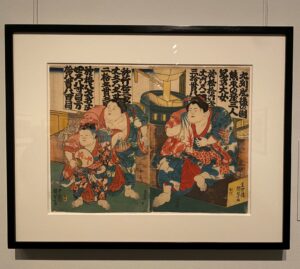 The legend of Auntie Po makes me directly think about this Japanese painting named “Girl power” that I saw in the National Museum of Asian Art, and I am surprised to find how many similarities they share.
The legend of Auntie Po makes me directly think about this Japanese painting named “Girl power” that I saw in the National Museum of Asian Art, and I am surprised to find how many similarities they share.
This painting is created in 1856, around the same period as the story of Mei and Auntie Po, and it is demonstrating three female sumo wrestlers preparing for the match. The greatest similarity between this painting and the legend of Auntie Po is that they both try to show the power of women by letting them do something that men are supposed to do. Just like how logging is supposed to be male-dominated work and the legend of Paul Bunyan is a legend of a man, sumo wrestling is also considered a men’s sport in Japan. Moreover, in great contrast with the low social status of female in Japanese culture in history, sumo wrestler has high social status and is always respected by society as the symbol of power. By letting female be the myth of logging and doing men’s sport, both of these two works rebels against the traditional label of being weak women and shows that women can also be powerful.
Another similarity is that they all have an Asian background. Although discrimination against women is everywhere around the world, it is more severe in Asian culture, in which women are always supposed to be passive, be the ones waiting to be saved, and sacrifice themselves for men’s success. However, in these two works, we see that Asian women, dressing in traditional clothes, can be the hero! We can see Auntie Po saving people from the river, and the three strong girls ready to fight, and these are all opposite to what they are supposed to do in their culture. Indeed, they even surpass most men, as Auntie Po is the one who can log the greatest number of trees, and sumo wrestlers are considered to be the strongest group of people in Japan.
The last similarity they share is that although they are trying to show that females can be strong and powerful, they both show it through the male’s frame. They do it by drawing females with muscular bodies. Especially in this Japanese painting, all these girls are giants. In other words, they show women are powerful by making them like men, which might imply that only the figure of men is powerful.